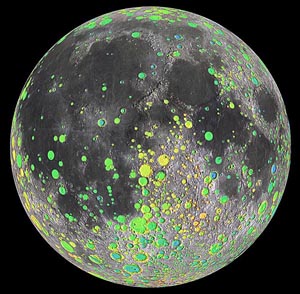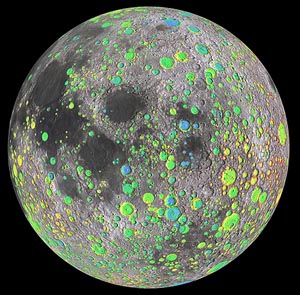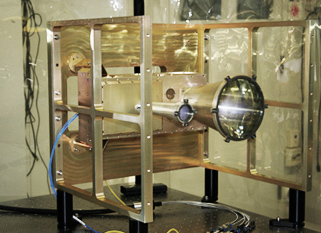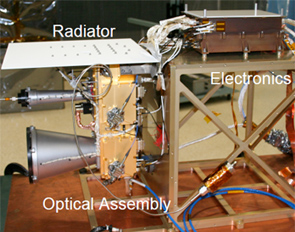LOLA
Contents
[hide]Lunar Orbiter Laser Altimeter (LOLA)
Right: Credit: David Smith et al - another view.
Description
The LOLA instrument is a payload onboard the Lunar Reconnaissance Orbiter spacecraft that launched to the Moon on 19 June 2009. Using five laser beams that illuminate the lunar surface (created from a single laser beam passing through a diffractive optical system), LOLA turns the reflected beams into data about the Moon. These data can include findings, for example, about the moon’s surface topography, its roughness, slope and reflectance, but also, primarily, provide vital information for a global geodetic grid for the Moon.
Description: Wikipedia
Additional Information
- Recent LOLA data (2010):


Images above show just two views from recent LOLA research by James Head (et al) who carried out a global census of 5185 craters greater than or equal to 20 kilometres in size. Colours in Green represent the global ‘mean’ elevation value, Blue is below this value, while Yellow is above. Note, how the basin regions (dark regions) show less craters in the range, while those in the highland regions are much higher. Head’s research points to the fact that there were two populations of impactors in the early solar system history, and that the transition occurred near the time of the Orientale Basin event - around the Late Imbrium period (~ 3.85 to 3.75 bn years). - JohnMoore2
Credit: NASA’s Scientific Visualization Studio. - LOLA’s laser pulses can be upto 140/sec working at approximately ±10 cm range measurements at 28 Hz.
- Principal investigators: David Smith, Maria Zuber.
- LOLA data are available to the public through the periodic releases of LRO datasets on NASA's PDS, and also sometimes a bit in advance on the MIT site.
- Various amateur products are available for dealing with LOLA data.
- The MIT experimenters regularly provide files for use with Celestia
- Recent versions of the Lunar Terminator Visualization Tool can create synthesized lunar views using most of the LOLA gridded data sets, and give a LOLA-based height readout as a mouse is moved over surface images.
- Various amateur products are available for dealing with LOLA data.
LPOD Articles
Bibliography
Head, J. W. et al (2010). Global Distribution of Large Lunar Craters: Implications for Resurfacing and Impactor Populations – Science, Vol. 329. no. 5998, pp. 1504 – 1507, 17 September 2010.
Beatty, K. (2010). The Moon Through LRO’s Eyes – Sky & Telescope, September 2010.
Smith, D. E. et al (2008). The Lunar Orbiter Laser Altimeter Investigation on the Lunar Reconnaissance Orbiter Mission – Space Science Reviews 2008.

